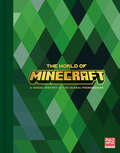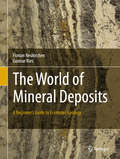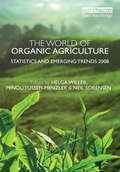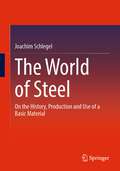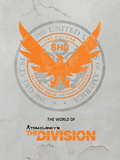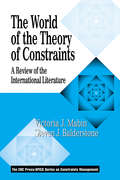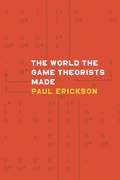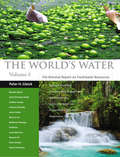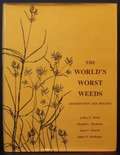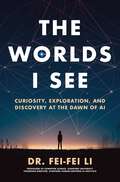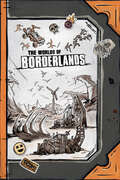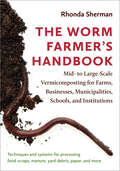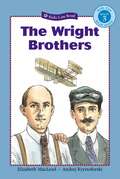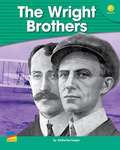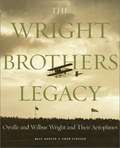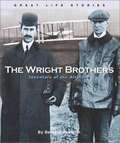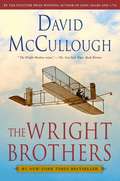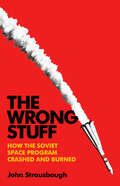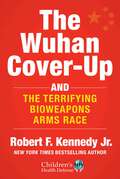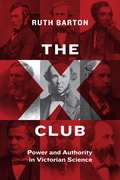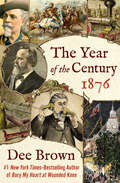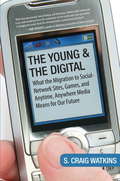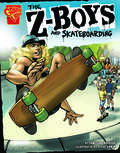- Table View
- List View
The World of Minecraft (Minecraft)
by Mojang ABUncover the history of one of the most influential games of all time in The World of Minecraft. Explore how the critically acclaimed game evolved from a one-person project in 2009 to the global gaming phenomenon it is today. The World of Minecraft is the definitive account of the game&’s history, combining exclusive interviews from the Mojang studio and recollections from long-standing members of the gaming community. Read the stories behind mods like Feed The Beast, the growth of community-defining servers like Hypixel, and YouTube channels like The Yogscast, plus a personal account from Lydia Winters on the creation of Alex, the impact of Minecraft charity Block by Block, the origin of the phantom, and many more insights.This must-have collector&’s item includes a foreword from chief creative officer Jens &“Jeb&” Bergensten and an afterword from vanilla Minecraft game director Agnes Larsson, plus original concept art, beautifully detailed renders, and previously unseen archive materials that illustrate how the game has developed over its first fifteen years. Journey back into past eras of the game and look to the future in this comprehensive chronicle of Minecraft&’s story.
The World of Mineral Deposits: A Beginner's Guide to Economic Geology
by Florian Neukirchen Gunnar RiesThis vivid introduction to economic geology not only describes the most important deposit types, but also the processes involved in their formation. Magmatic, hydrothermal and sedimentary processes as well as weathering and alteration are explained in the framework of plate tectonics and the history of the Earth. The chapter about fossil fuels includes unconventional deposits and the much-debated fracking. Other topics covered are exploration, mining and economic aspects like commodity prices.
The World of Organic Agriculture: Statistics and Emerging Trends 2008
by Minou Yussefi-MenzlerThe new edition of this annual publication (previously published solely by IFOAM and FiBL) documents recent developments in global organic agriculture. It includes contributions from representatives of the organic sector from throughout the world and provides comprehensive organic farming statistics that cover surface area under organic management, numbers of farms and specific information about commodities and land use in organic systems. The book also contains information on the global market of the burgeoning organic sector, the latest developments in organic certification, standards and regulations, and insights into current status and emerging trends for organic agriculture by continent from the worlds foremost experts. For this edition, all statistical data and regional review chapters have been thoroughly updated. Completely new chapters on organic agriculture in the Pacific, on the International Task Force on Harmonization and Equivalence in Organic Agriculture and on organic aquaculture have been added. Published with IFOAM and FiBL
The World of Steel: On the History, Production and Use of a Basic Material
by Joachim SchlegelThe world of steel is constantly evolving and has become astonishingly diverse, indeed so complex that it is not easy to keep track of it in practice. The aim is to give readers an understanding of this world, from steelmaking, ingot and continuous casting, forming and machining to finishing, testing and packaging of the products, the processes and equipment predominantly used throughout, including the environmentally compatible recycling and disposal of waste.
The World of Tom Clancy's The Division
by UbisoftIncisive lore and detailed art in a cunningly designed hardcover that will bring readers into the ravaged streets of New York City and Washington DC as seen in Ubisoft's record-breaking videogame series!On Black Friday, a deadly biological attack was thrust upon the populace of New York. Within weeks, millions lay dead, and the city was placed under quarantine. The only force with any hope of restoring order are the embedded agents of the SHD--more commonly known as the Division. Despite the quarantine, the infection continues to spread across the country. Amidst a ruined government, a shattered infrastructure, and an eroding civilization, the Division is now called to action in Washington DC--but if the agents fail, the capital will fall, and the nation with it.The World of Tom Clancy's The Division is the meticulously crafted result of a partnership between Dark Horse books and Ubisoft Entertainment, offering readers a unique insight into the chaotic and dangerous world of the hit games. Don't miss this opportunity to learn all there is to know about the tactical methods, the high-tech tools, and the all-important mission of the Division!
The World of the Small Commercial Fishermen: Their Lives and Their Boats
by Michael MeltzerIncorporating elements of anthropology, marine biology, and marine technology, Michael Meltzer's story of men and boats weaves together actual interviews with fishermen from all three coasts, vivid descriptions of their lives, the ways of the communities in which they live, and many fascinating details -- about fishing vessels, fishing gear, and numerous kinds of fish.<P>From a salmon puller's story to fisherman's superstitions and harbor hierarchies, geologist-teacher Meltzer's account is colorful, serious, anecdotal, and informational.
The World of the Theory of Constraints: A Review of the International Literature (The CRC Press Series on Constraints Management)
by Victoria J Mabin Steven J BalderstoneThe Theory of Constraints (TOC) - as developed by Dr. Eliyahu Goldratt - has seen a rapid expansion since the publication of his book, The Goal. As with most fast growing areas, you can quickly feel out of touch with new developments. The World of the Theory of Constraints provides a summary of recently published research on TOC. The authors explored databases, and sought out papers and books drawing on as wide a range as possible. Aside from the works by Dr. Goldratt himself, the authors focus on items published since 1990, highlighting the most recent developments in TOC. The scope of the material covers works containing specific reference to TOC, including Synchronous Manufacturing and Constraint Management.The book is organized into three sections. The first section contains an analysis and interpretation of the results of the search. The second provides abstracts on all the material. The third supplies author, keyword, and subject indexes along with a list of books, journals, websites, and publishers. Extensively researched and referenced, The World of the Theory of Constraints furnishes comprehensive material on TOC. The multi-search approach has made this arguably the most exhaustive bibliography on this subject available. If you are researching TOC, this is the best place to start. If you use or teach TOC, you will want this resource.Features
The World the Game Theorists Made
by Paul EriksonIn recent decades game theory--the mathematics of rational decision-making by interacting individuals--has assumed a central place in our understanding of capitalist markets, the evolution of social behavior in animals, and even the ethics of altruism and fairness in human beings. With game theory's ubiquity, however, has come a great deal of misunderstanding. Critics of the contemporary social sciences view it as part of an unwelcome trend toward the marginalization of historicist and interpretive styles of inquiry, and many accuse its proponents of presenting a thin and empirically dubious view of human choice. The World the Game Theorists Made seeks to explain the ascendency of game theory, focusing on the poorly understood period between the publication of John von Neumann and Oscar Morgenstern's seminal Theory of Games and Economic Behavior in 1944 and the theory's revival in economics in the 1980s. Drawing on a diverse collection of institutional archives, personal correspondence and papers, and interviews, Paul Erickson shows how game theory offered social scientists, biologists, military strategists, and others a common, flexible language that could facilitate wide-ranging thought and debate on some of the most critical issues of the day.
The World's Water
by Peter H. GleickAmong the most compelling environmental issues of today and tomorrow are those concerning the world's fresh water resources. Peter H. Gleick's important new volume, Water in Crisis, addresses the timely and sometimes controversial aspects of world water use. At stake are water quality, quantity, and possible future conflicts over shared international water resources. Nine essays by leading specialists from fields as diverse as hydrology, zoology, and law, among others, cover such issues as the status of developments in international water law; hydroelectric power; the possible effects of climatic change on water resources; and the state of fresh water fisheries. Particular chapters explore access to clean drinking water and sanitation; the use of water for energy and food production; the quality of rivers, lakes, and inland seas; and the condition of natural aquatic ecosystems. A joint project of the Pacific Institute and the Stockholm Environment Institute, this book is a comprehensive guide to the world's fresh water resources. Hydrologists, engineers, policy makers, professionals in the environmental sciences, as well as lay readers will find Water in Crisis a dynamic resource and information-packed reference. More than 200 tables of fresh water data supplement this important volume.
The World's Worst Weeds: Distribution and Biology
by Donald L. Plucknett LeRoy G. Holm Juan V. Pancho James P. HerbergerThis is an inventory of the principal weeds of the world’s major crops, with particular emphasis on their distribution, seriousness, and their known biology. From the time man first learned to plant seeds and harvest crops, weeds have been rather casually accepted as an inevitable nuisance. Only in recent years have we become aware of the staggering losses inflicted on a food-short world by destructive weeds. The origins of this book are deeply buried in this tradition of general acceptance of destruction by the world’s worst weeds, and it is the authors’ hope that this inventory may in some small way help the efforts of scientists and policymakers as they tackle a problem which can be solved.
The Worlds I See: Curiosity, Exploration, and Discovery at the Dawn of AI
by Fei-Fei LiONE OF BARACK OBAMA'S RECOMMENDED BOOKS ON AI * FINANCIAL TIMES BEST BOOKS OF 2023From Dr. Fei-Fei Li, one of TIME's 100 MOST INFLUENTIAL in AI, comes "a powerful plea for keeping humanity at the centre of our latest technological transformation" (Financial Times).Wired called Dr. Fei-Fei Li “one of a tiny group of scientists—a group perhaps small enough to fit around a kitchen table—who are responsible for AI’s recent remarkable advances.”Known to the world as the creator of ImageNet, a key catalyst of modern artificial intelligence, Dr. Li has spent more than two decades at the forefront of the field. But her career in science was improbable from the start. As immigrants, her family faced a difficult transition from China’s middle class to American poverty. And their lives were made all the harder as they struggled to care for her ailing mother, who was working tirelessly to help them all gain a foothold in their new land.Fei-Fei’s adolescent knack for physics endured, however, and positioned her to make a crucial contribution to the breakthrough we now call AI, placing her at the center of a global transformation. Over the last decades, her work has brought her face-to-face with the extraordinary possibilities—and the extraordinary dangers—of the technology she loves.The Worlds I See is a story of science in the first person, documenting one of the century’s defining moments from the inside. It provides a riveting story of a scientist at work and a thrillingly clear explanation of what artificial intelligence actually is—and how it came to be. Emotionally raw and intellectually uncompromising, this book is a testament not only to the passion required for even the most technical scholarship but also to the curiosity forever at its heart.
The Worlds of Borderlands
by Rick BarbaExplore a universe run amok with savage beasts, bloodthirsty bandits, and the biggest bad of all—corporations, in this full-color hardcover encyclopedia of Gearbox&’s beloved videogame franchise!The universe of Borderlands is an inhospitable wilderness that spans every biome conceivable. It&’s also a land full of opportunity, but only if you have wits, skill, and guns. Lots of guns. Many come to Pandora in search of the Vault in the hopes of finding wealth, fame, or power. This is the definitive guide to the bold people who live there and in the surrounding galaxy, the mercenaries, monsters, and wilds they contend with, and the ridiculous arsenal they employ.Dark Horse Books and Gearbox present The Worlds of Borderlands—a bombastic guide to Pandora, its surrounding planets and the characters who live there. This volume is filled with art and trivia relating to the guns, vehicles, ships, companies, and adventurers of the worlds-spanning universe—and the monstrous fauna who would eat all of them.
The Worm Farmers Handbook: Mid- to Large-Scale Vermicomposting for Farms, Businesses, Municipalities, Schools, and Institutions
by Rhonda ShermanChoice Reviews, Outstanding Academic TitleTechniques and systems for processing food scraps, manure, yard debris, paper, and moreTurning waste into wealth sounds too good to be true, but many worm farmers are finding that vermicomposting is a reliable way to do just that. Vermicast—a biologically active, nutrient-rich mix of earthworm castings and decomposed organic matter—sells for $400 or more per cubic yard. Compare that to regular compost, sold at about $30 a cubic yard, and you&’ll see why vermicomposting has taken root in most countries and on every continent but Antarctica.Vermicomposting is also one of the best sustainable solutions for organic waste management. Vermicomposting manure and crop wastes on farms improves crop yields while reducing demand for off-farm inputs. Vermicast has higher nutrient levels and lower soluble salt content than regular compost, and it improves soil aeration, porosity, and water retention. Plus, vermicast suppresses plant diseases and insect attacks. Municipalities, businesses, community gardens, schools, and universities can set up vermicomposting operations to process food residuals and other waste materials.The Worm Farmer&’s Handbook details the ins and outs of vermicomposting for mid- to large-scale operations, including how to recycle organic materials ranging from food wastes and yard trimmings to manure and shredded office paper. Vermicomposting expert Rhonda Sherman shares what she has learned over twenty-five years working with commercial worm growers and researchers around the world. Her profiles of successful worm growers across the United States and from New Zealand to the Middle East and Europe describe their proven methods and systems.This book digs into all the details, including:Choosing the right production systemRegulatory issues and developing a business and marketing planFinding and managing feedstocksPre-composting: why and how to do itMonitoring an active worm bedHarvesting, screening, testing, packaging, and storing vermicastMarkets for earthworms and vermicastFood security: how vermicast benefits soils and plantsKeys to success: avoiding common pitfallsFrom livestock farms and restaurants to colleges, military bases, and prisons, Sherman details why and how commercial-scale vermicomposting is a fast-growing, sustainable solution for organic waste management. The Worm Farmer&’s Handbook is the first and only authoritative how-to guide that goes beyond small-scale operations and demystifies the science and logistics of the fascinating process that is vermicomposting.
The Wright Brothers
by Elizabeth MacleodMeet the Wright Brothers -- inventors of the airplane. The story of how they created one of the most influential machines in history is told in level-appropriate language.
The Wright Brothers Legacy: Orville and Wilbur Wright and Their Aeroplanes
by Walt Burton Owen FindsenFrom their early experiments with gliders to the first flight of a heavier-than-air aircraft, from their tours of European and American air shows to their development of a military aircraft to the final installation of the Kitty Hawk Flyer at the Smithsonian Institution in 1948, this volume celebrates an invention that changed the world.
The Wright Brothers: Inventors of the Airplane (Great Life Stories)
by Bernard Ryan Jr.The Wright Brothers were an amazing team who created one of the most revolutionary inventions of the twentieth century -- the airplane. Sons of a minister, Orville and Wilbur Wright were bright, industrious, and inseparable. As young men, they operated a print shop, published newspapers, and fixed and built bicycles. Orville and Wilbur began to actively pursue their dream of flying in the late 1890s. They built their first glider in 1900 and took it to Kitty Hawk, North Carolina, to test it. Three years later, Orville made the historic first flight on December 17. Their invention brought them much international attention. In 1909, they established the Wright American Company to build and sell their airplanes. Today, the Wright brothers are considered pioneers in the field of aviation. Book jacket.
The Wright Brothers: The Dramatic Story-behind-the-story
by David McCulloughThe #1 New York Times bestseller from David McCullough, two-time winner of the Pulitzer Prize—the dramatic story-behind-the-story about the courageous brothers who taught the world how to fly—Wilbur and Orville Wright.On a winter day in 1903, in the Outer Banks of North Carolina, two brothers—bicycle mechanics from Dayton, Ohio—changed history. But it would take the world some time to believe that the age of flight had begun, with the first powered machine carrying a pilot. Orville and Wilbur Wright were men of exceptional courage and determination, and of far-ranging intellectual interests and ceaseless curiosity. When they worked together, no problem seemed to be insurmountable. Wilbur was unquestionably a genius. Orville had such mechanical ingenuity as few had ever seen. That they had no more than a public high school education and little money never stopped them in their mission to take to the air. Nothing did, not even the self-evident reality that every time they took off, they risked being killed. In this “enjoyable, fast-paced tale” (The Economist), master historian David McCullough “shows as never before how two Ohio boys from a remarkable family taught the world to fly” (The Washington Post) and “captures the marvel of what the Wrights accomplished” (The Wall Street Journal). He draws on the extensive Wright family papers to profile not only the brothers but their sister, Katharine, without whom things might well have gone differently for them. Essential reading, this is “a story of timeless importance, told with uncommon empathy and fluency…about what might be the most astonishing feat mankind has ever accomplished…The Wright Brothers soars” (The New York Times Book Review).
The Wrong Stuff: How the Soviet Space Program Crashed and Burned
by John StrausbaughA witty, deeply researched history of the surprisingly ramshackle Soviet space program, and how its success was more spin than science. In the wake of World War II, with America ascendant and the Soviet Union devastated by the conflict, the Space Race should have been over before it started. But the underdog Soviets scored a series of victories--starting with the 1957 launch of Sputnik and continuing in the years following--that seemed to achieve the impossible. It was proof, it seemed, that the USSR had manpower and collective will that went beyond America's material advantages. They had asserted themselves as a world power. But in The Wrong Stuff, John Strausbaugh tells a different story. These achievements were amazing, yes, but they were also PR victories as much as scientific ones. The world saw a Potemkin spaceport; the internal facts were much sloppier, less impressive, more dysfunctional. The Soviet supply chain was a disaster, and many of its machines barely worked. The cosmonauts aboard its iconic launch of the Vostok 1 rocket had to go on a special diet, and take off their space suits, just to fit inside without causing a failure. Soviet scientists, under intense government pressure, had essentially made their rocket out of spit and band aids, and hurried to hide their work as soon as their worldwide demonstration was complete. With a witty eye for detail and a gift for storytelling, John Strausbaugh takes us behind the Iron Curtain, and shows just how little there was to find there.
The Wuhan Cover-Up: And the Terrifying Bioweapons Arms Race (Children’s Health Defense)
by Robert F. Kennedy Jr.&“RFK Jr. exposes the decades of lies.&”—Luc Montagnier, Nobel laureate From the New York Times, Wall Street Journal, USA Today, and Publishers Weekly bestselling author of The Real Anthony Fauci comes an explosive exposé of the cover-up behind the true origins of COVID-19. &“Gain-of-function&” experiments are often conducted to deliberately develop highly virulent, easily transmissible pathogens for the stated purpose of developing preemptive vaccines for animal viruses before they jump to humans. More insidious is the &“dual use&” nature of this research, specifically directed toward bioweapons development. The Wuhan Cover-Up pulls back the curtain on how the US government's increase in biosecurity spending after the 2001 terror attacks set in motion a plan to transform the National Institute of Allergy and Infectious Diseases (NIAID), under the direction of Dr. Anthony Fauci, into a de facto Defense Department agency. While Dr. Fauci zealously funded and pursued gain-of-function research, concern grew among some scientists and government officials about the potential for accidental or deliberate release of weaponized viruses from labs that might trigger worldwide pandemics. A moratorium was placed on this research, but true to form, Dr. Fauci found ways to continue unperturbed—outsourcing some of the most controversial experiments offshore to China and providing federal funding to Wuhan Institute of Virology's (WIV's) leading researchers for gain-of-function studies in partnership with the Chinese military and the Chinese Communist Party. Robert F. Kennedy Jr.'s meticulously researched and rigorously sourced analysis leads readers on a staggering journey to learn about: the key enablers and henchmen pushing for gain-of-function research the economic motives behind gain-of-function research successfully engineered &“chimeric viruses&” that can infect and kill humans the coordinated effort to silence speculation of COVID-19&’s laboratory genesis the complicity of scientific journals to hide the origins of COVID-19 the role of the Wuhan Institute of Virology in China&’s biowarfare/biodefense program the relationships between US health, military, and intelligence bureaucracies and scientists and their Chinese counterparts the roles of Bill Gates and Sir Jeremy Farrar in orchestrating a global cover-up The Wuhan Cover-Up unveils a global conspiracy of epic proportion and lethal consequence.
The X Club: Power and Authority in Victorian Science
by Ruth BartonIn 1864, amid headline-grabbing heresy trials, members of the British Association for the Advancement of Science were asked to sign a declaration affirming that science and scripture were in agreement. Many criticized the new test of orthodoxy; nine decided that collaborative action was required. The X Club tells their story. These six ambitious professionals and three wealthy amateurs—J. D. Hooker, T. H. Huxley, John Tyndall, John Lubbock, William Spottiswoode, Edward Frankland, George Busk, T. A. Hirst, and Herbert Spencer—wanted to guide the development of science and public opinion on issues where science impinged on daily life, religious belief, and politics. They formed a private dining club, which they named the X Club, to discuss and further their plans. As Ruth Barton shows, they had a clear objective: they wanted to promote “scientific habits of mind,” which they sought to do through lectures, journalism, and science education. They devoted enormous effort to the expansion of science education, with real, but mixed, success. For twenty years, the X Club was the most powerful network in Victorian science—the men succeeded each other in the presidency of the Royal Society for a dozen years. Barton’s group biography traces the roots of their success and the lasting effects of their championing of science against those who attempted to limit or control it, along the way shedding light on the social organization of science, the interactions of science and the state, and the places of science and scientific men in elite culture in the Victorian era.
The Year of the Century, 1876: 1876
by Dee BrownDee Brown&’s sparkling account of a momentous year in American historyIn 1876, America was eager to celebrate its centenary, but questioned what might lie ahead. The American Republic had grown to four times its original population, and was in the midst of enormous changes. Industrialization was booming, and new energy sources were being used for fuel and power. People were suddenly less bound to agriculture, and there were revolutions in transportation and communication. It was a time of Indian wars, the first stirrings of the labor movement, and the burgeoning struggle form women&’s and other civil rights. Historian Dee Brown takes the measure of America in a rare moment of reflection on the nation&’s past, present, and future. The Year of the Century was one of Brown&’s favorites among his works. In page-turning prose, he tells of a tumultuous era and of a young nation taking stock. This ebook features an illustrated biography of Dee Brown including rare photos from the author&’s personal collection.
The Young and the Digital
by S. Craig WatkinsIn The Young and the Digital, S. Craig Watkins skillfully draws from more than 500 surveys and 350 in-depth interviews with young people, parents, and educators to understand how a digital lifestyle is affecting the ways youth learn, play, bond, and communicate. Timely and deeply relevant, the book covers the influence of MySpace and Facebook, the growing appetite for "anytime, anywhere" media and "fast entertainment," how online "digital gates" reinforce race and class divisions, and how technology is transforming America's classrooms. Watkins also debunks popular myths surrounding cyberpredators, Internet addiction, and social isolation. The result is a fascinating portrait, both celebratory and wary, about the coming of age of the first fully wired generation. From the Trade Paperback edition.
The Z-Boys and Skateboarding (Inventions and Discovery)
by Jameson AndersonDescribes the birth of the Z-Boys skateboarding team and how they influenced modern skateboarding. Written in graphic-novel format.
